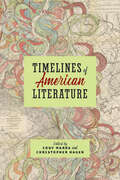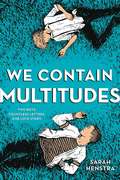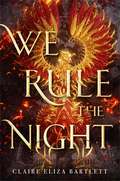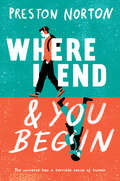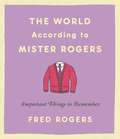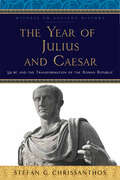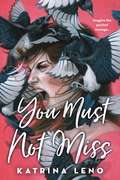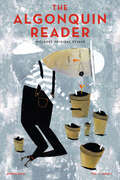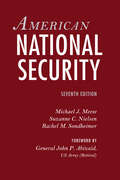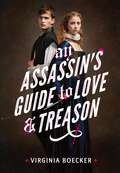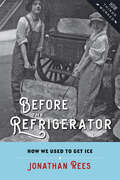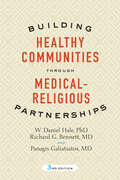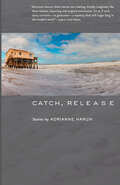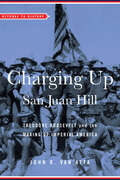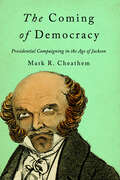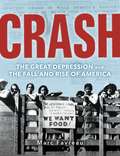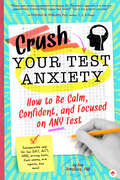- Table View
- List View
Timelines of American Literature
by Cody Marrs Christopher HagerIt is all but inevitable for literary history to be divided into periods. "Early American," "antebellum," "modern," "post-1945";¢;‚¬;€?such designations organize our knowledge of the past and shape the ways we discuss that past today. These periods tend to align with the watershed moments in American history, even as the field has shifted its perspective away from the nation-state. It is high time we rethink these defining periods of American literary history, as the drawing of literary timelines is a necessary;¢;‚¬;€?even illuminating;¢;‚¬;€?practice.In these short, spirited, and imaginative essays, 23 leading Americanists gamely fashion new, unorthodox literary periods;¢;‚¬;€?from 600 B.C.E. to the present, from the Age of Van Buren to the Age of Microeconomics. They bring to light literary and cultural histories that have been obscured by traditional timelines and raise provocative questions. What is our definition of "modernism" if we imagine it stretching from 1865 to 1965 instead of 1890 to 1945? How does the captivity narrative change when we consider it as a contemporary, not just a "colonial," genre? What does the course of American literature look like set against the backdrop of federal denials of Native sovereignty or housing policies that exacerbated segregation? Filled with challenges to scholars, inspirations for teachers (anchored by an appendix of syllabi), and entry points for students, Timelines of American Literature gathers some of the most exciting new work in the field to showcase the revelatory potential of fresh thinking about how we organize the literary past.
Timelines of American Literature
by Cody Marrs Christopher HagerIt is all but inevitable for literary history to be divided into periods. "Early American," "antebellum," "modern," "post-1945";¢;‚¬;€?such designations organize our knowledge of the past and shape the ways we discuss that past today. These periods tend to align with the watershed moments in American history, even as the field has shifted its perspective away from the nation-state. It is high time we rethink these defining periods of American literary history, as the drawing of literary timelines is a necessary;¢;‚¬;€?even illuminating;¢;‚¬;€?practice.In these short, spirited, and imaginative essays, 23 leading Americanists gamely fashion new, unorthodox literary periods;¢;‚¬;€?from 600 B.C.E. to the present, from the Age of Van Buren to the Age of Microeconomics. They bring to light literary and cultural histories that have been obscured by traditional timelines and raise provocative questions. What is our definition of "modernism" if we imagine it stretching from 1865 to 1965 instead of 1890 to 1945? How does the captivity narrative change when we consider it as a contemporary, not just a "colonial," genre? What does the course of American literature look like set against the backdrop of federal denials of Native sovereignty or housing policies that exacerbated segregation? Filled with challenges to scholars, inspirations for teachers (anchored by an appendix of syllabi), and entry points for students, Timelines of American Literature gathers some of the most exciting new work in the field to showcase the revelatory potential of fresh thinking about how we organize the literary past.
We Contain Multitudes
by Sarah HenstraAristotle and Dante Discover the Secrets of the Universe meets I'll Give You the Sun in an exhilarating and emotional novel about the growing relationship between two teenage boys, told through the letters they write to one another. Jonathan Hopkirk and Adam "Kurl" Kurlansky are partnered in English class, writing letters to one another in a weekly pen pal assignment. With each letter, the two begin to develop a friendship that eventually grows into love. But with homophobia, bullying, and devastating family secrets, Jonathan and Kurl struggle to overcome their conflicts and hold onto their relationship...and each other.This rare and special novel celebrates love and life with engaging characters and stunning language, making it perfect for fans of Jandy Nelson, Nina LaCour, and David Levithan.
We Rule the Night
by Claire Eliza BartlettTwo girls use forbidden magic to fly and fight--for their country and for themselves--in this riveting debut that's part Shadow and Bone, part Code Name Verity.Seventeen-year-old Revna is a factory worker, manufacturing war machines for the Union of the North. When she's caught using illegal magic, she fears being branded a traitor and imprisoned. Meanwhile, on the front lines, Linné defied her father, a Union general, and disguised herself as a boy to join the army. They're both offered a reprieve from punishment if they use their magic in a special women's military flight unit and undertake terrifying, deadly missions under cover of darkness. Revna and Linné can hardly stand to be in the same cockpit, but if they can't fly together, and if they can't find a way to fly well, the enemy's superior firepower will destroy them--if they don't destroy each other first.We Rule the Night is a fiercely compelling story about sacrifice, complicated friendships, and survival against impossible odds.
Where I End and You Begin
by Preston NortonTwo sworn enemies suddenly switch bodies in this witty and heartfelt novel of romantic relationships, gender identity, and the joy of being yourself.Ezra Slevin is an anxious, neurotic insomniac who spends his nights questioning his place in the universe and his days obsessing over Imogen, a nerdy girl with gigantic eyebrows and a heart of gold. For weeks, Ezra has been working up the courage to invite Imogen to prom. The only problem is Imogen's protective best friend, Wynonna Jones. Wynonna has blue hair, jams to '80s rock, and has made a career out of tormenting Ezra for as long as he can remember.Then, on the night of a total solar eclipse, something strange happens to Ezra and Wynonna, and they wake up in each other's bodies. Not only that, they begin randomly swapping back and forth every day! Ezra soon discovers Wynonna's huge crush on his best friend, Holden, a five-foot-nothing girl magnet with anger management problems. With no end to their curse in sight, Ezra makes Wynonna a proposition: While swapping bodies, he will help her win Holden's heart, but only if she helps him woo Imogen.Forming an uneasy alliance, Ezra and Wynonna embark on a collision course of mistaken identity, hurt feaelings, embarrassing bodily functions, and a positively byzantine production of Twelfth Night. Ezra wishes he could be more like Wynonna's badass version of Ezra -- but he also realizes he feels more like himself while being Wynonna than he has in a long time.Wildly entertaining and deeply heartfelt, Where I End and You Begin is a brilliant, unapologetic exploration of what it means to be your best self.
The World According to Mister Rogers: Important Things to Remember (Charming Petite Ser.)
by Fred RogersA timeless collection of wisdom on love, friendship, respect, individuality, and honesty from the beloved PBS series Mister Rogers' Neighborhood.There are few personalities who evoke such universal feelings of warmth as Fred Rogers. An enduring presence in American homes for over 30 years, his plainspoken wisdom continues to guide and comfort many. The World According to Mister Rogers distills the legacy and singular worldview of this beloved American figure. An inspiring collection of stories, anecdotes, and insights--with sections devoted to love, friendship, respect, individuality, and honesty, The World According to Mister Rogers reminds us that there is much more in life that unites us than divides us.Culled from Fred Rogers' speeches, program transcripts, books, letters, and interviews, along with some of his never-before-published writings, The World According to Mister Rogers is a testament to the legacy of a man who served and continues to serve as a role model to millions.
The Year of Julius and Caesar: 59 BC and the Transformation of the Roman Republic (Witness to Ancient History)
by Stefan G. ChrissanthosThe year 59 BC—when Gaius Julius Caesar and Marcus Calpurnius Bibulus served as joint consuls—marked a major turning point in the history of the Roman Republic. It was a dramatic and momentous time of political intrigue, bloodshed, and murder, one that boasted some of the most famous personalities ever to grace the Roman historical stage. Arguing that this pivotal year demands extended study, Stefan G. Chrissanthos's The Year of Julius and Caesar is the first focused investigation of the period.Chrissanthos uses a single event as his centerpiece: the violent attack orchestrated by Caesar and the "First Triumvirate" on Bibulus and his followers in the Forum on April 4. Before that day, he reveals, 59 had been a typical year, one that provides valuable insight into Roman government and political gamesmanship. But the assault on Bibulus changed everything: the consul retired to his house for the rest of the year, allowing Caesar and his allies to pass legislation that eventually enabled Caesar to take complete control of the Roman state. This detailed reconstruction draws on archeological and literary evidence to describe a watershed year in the history of the late Roman Republic, establish an accurate chronology, and answer many of the important historical questions surrounding the year 59. Written in an engaging and accessible style, The Year of Julius and Caesar will appeal to undergraduates and scholars alike and to anyone interested in contemporary politics, owing to the parallels between the Roman and American Republics.
The Year of Julius and Caesar: 59 BC and the Transformation of the Roman Republic (Witness to Ancient History)
by Stefan G. ChrissanthosThe year 59 BC—when Gaius Julius Caesar and Marcus Calpurnius Bibulus served as joint consuls—marked a major turning point in the history of the Roman Republic. It was a dramatic and momentous time of political intrigue, bloodshed, and murder, one that boasted some of the most famous personalities ever to grace the Roman historical stage. Arguing that this pivotal year demands extended study, Stefan G. Chrissanthos's The Year of Julius and Caesar is the first focused investigation of the period.Chrissanthos uses a single event as his centerpiece: the violent attack orchestrated by Caesar and the "First Triumvirate" on Bibulus and his followers in the Forum on April 4. Before that day, he reveals, 59 had been a typical year, one that provides valuable insight into Roman government and political gamesmanship. But the assault on Bibulus changed everything: the consul retired to his house for the rest of the year, allowing Caesar and his allies to pass legislation that eventually enabled Caesar to take complete control of the Roman state. This detailed reconstruction draws on archeological and literary evidence to describe a watershed year in the history of the late Roman Republic, establish an accurate chronology, and answer many of the important historical questions surrounding the year 59. Written in an engaging and accessible style, The Year of Julius and Caesar will appeal to undergraduates and scholars alike and to anyone interested in contemporary politics, owing to the parallels between the Roman and American Republics.
You Must Not Miss
by Katrina LenoOne of Us Is Lying meets Carrie in this suspenseful story of friendship, family, and revenge.Magpie Lewis started writing in her yellow notebook the day after her family self-destructed. The day her father ruined her mother's life. The day Eryn, Magpie's sister, skipped town and left her to fend for herself. The day of Brandon Phipp's party.Now Magpie is called a slut in the hallways of her high school, her former best friend won't speak to her, and she spends her lunch period with a group of misfits who've all been as socially exiled as she has. And so, feeling trapped and forgotten, Magpie retreats to her notebook, dreaming up a magical place called Near.Near is perfect - a place where her father never cheated, her mother never drank, and Magpie's own life never derailed so suddenly. She imagines Near so completely, so fully, that she writes it into existence, right in her own backyard. At first, Near is a peaceful escape, but soon it becomes something darker, somewhere nightmares lurk and hidden truths come to light. Soon it becomes a place where Magpie can do anything she wants...even get her revenge.You Must Not Miss is an intoxicating, twisted tale of magic, menace, and the monsters that live inside us all.
The Algonquin Reader: Spring 2018
by Algonquin Books of Chapel HillGet an inside look at Algonquin&’s outstanding forthcoming fiction with the Spring 2018 Algonquin Reader. Discover the inspiration behind each book through an original essay by the author. Then enjoy a short preview of each novel. The books featured in this issue are:The Optimistic Decade by Heather Abel On Sale May 2018Dreadful Young Ladies and Other Stories by Kelly Barnhill On Sale February 2018Lawn Boy by Jonathan Evison On Sale April 2018Remind Me Again What Happened by Joanna Luloff On Sale June 2018The Price of the Haircut: Stories by Brock Clarke On Sale March 2018Southernmost by Silas House On Sale June 2018 Cover illustration by Mark Hoffmann.
American National Security
by Michael J. Meese Suzanne C. Nielsen Rachel M. SondheimerAmerican National Security remains the ideal foundational text for courses in national security, foreign policy, and security studies. Every chapter in this edition has been extensively revised, and the book includes discussion of recent security policy changes in the Trump administration. Highlights include:;€¢ An updated look at national security threats, military operations, and homeland security challenges ;€¢ An analysis of the evolving roles of the president, Congress, the intelligence community, the military, and other institutions involved in national security;€¢ A revised consideration of the strengths, limitations, and employment of instruments of national power, including diplomacy, information, economic tools, and armed forces;€¢ An exploration of the economic and national security implications of globalization;€¢ An enhanced examination of the proliferation of transnational threats, including security challenges in space and in cyberspace;€¢ A new assessment of how international, political, and economic trends may change US leadership of the post;€“World War II international order;€¢ A comprehensive update on changing dynamics in key states and regions, including Russia, China, East Asia, the Middle East, South Asia, Europe, Sub-Saharan Africa, and Latin AmericaAn authoritative book that explains US national security policy, actors, and processes in a wide-ranging yet understandable way, American National Security addresses key issues, including challenges to the free and open international order, the reemergence of strategic competition among great powers, terrorism, economic and fiscal constraints, and rapid advances in information and technology.
An Assassin's Guide to Love and Treason
by Virginia BoeckerShakespeare in Love meets Mr. and Mrs. Smith in this witty and thrilling story of star-crossed assassins in Elizabeth England, perfect for fans of My Lady Jane and TheGentleman's Guide to Vice and Virtue! When Lady Katherine's father is killed for being an illegally practicing Catholic, she discovers treason wasn't the only secret he's been hiding: he was also involved in a murder plot against the reigning Queen Elizabeth I. With nothing left to lose, Katherine disguises herself as a boy and travels to London to fulfill her father's mission, and to take it one step further -- kill the queen herself. Katherine's opportunity comes in the form of William Shakespeare's newest play, which is to be performed in front of Her Majesty. But what she doesn't know is that the play is not just a play. It's a plot to root out insurrectionists and destroy the rebellion once and for all. The mastermind behind this ruse is Toby Ellis, a young spy for the queen with secrets of his own. When Toby and Katherine are cast opposite each other as the play's leads, they find themselves inexplicably drawn to one another. But the closer they grow, the more precarious their positions become. And soon they learn that star-crossed love, mistaken identity, and betrayal are far more dangerous off the stage than on.
Before the Refrigerator: How We Used to Get Ice (How Things Worked)
by Jonathan ReesDuring the late nineteenth and early twentieth centuries, Americans depended upon ice to stay cool and to keep their perishable foods fresh. Jonathan Rees tells the fascinating story of how people got ice before mechanical refrigeration came to the household. Drawing on newspapers, trade journals, and household advice books, Before the Refrigerator explains how Americans built a complex system to harvest, store, and transport ice to everyone who wanted it, even the very poor.Rees traces the evolution of the natural ice industry from its mechanization in the 1880s through its gradual collapse, which started after World War I. Meatpackers began experimenting with ice refrigeration to ship their products as early as the 1860s. Starting around 1890, large, bulky ice machines the size of small houses appeared on the scene, becoming an important source for the American ice supply. As ice machines shrunk, more people had access to better ice for a wide variety of purposes. By the early twentieth century, Rees writes, ice had become an essential tool for preserving perishable foods of all kinds, transforming what most people ate and drank every day. Reviewing all the inventions that made the ice industry possible and the way they worked together to prevent ice from melting, Rees demonstrates how technological systems can operate without a central controlling force. Before the Refrigerator is ideal for history of technology classes, food studies classes, or anyone interested in what daily life in the United States was like between 1880 and 1930.
Before the Refrigerator: How We Used to Get Ice (How Things Worked)
by Jonathan ReesDuring the late nineteenth and early twentieth centuries, Americans depended upon ice to stay cool and to keep their perishable foods fresh. Jonathan Rees tells the fascinating story of how people got ice before mechanical refrigeration came to the household. Drawing on newspapers, trade journals, and household advice books, Before the Refrigerator explains how Americans built a complex system to harvest, store, and transport ice to everyone who wanted it, even the very poor.Rees traces the evolution of the natural ice industry from its mechanization in the 1880s through its gradual collapse, which started after World War I. Meatpackers began experimenting with ice refrigeration to ship their products as early as the 1860s. Starting around 1890, large, bulky ice machines the size of small houses appeared on the scene, becoming an important source for the American ice supply. As ice machines shrunk, more people had access to better ice for a wide variety of purposes. By the early twentieth century, Rees writes, ice had become an essential tool for preserving perishable foods of all kinds, transforming what most people ate and drank every day. Reviewing all the inventions that made the ice industry possible and the way they worked together to prevent ice from melting, Rees demonstrates how technological systems can operate without a central controlling force. Before the Refrigerator is ideal for history of technology classes, food studies classes, or anyone interested in what daily life in the United States was like between 1880 and 1930.
Building Healthy Communities through Medical-Religious Partnerships
by W. Daniel Hale Richard G. Bennett Panagis GaliatsatosBecause health care works best when patients assume greater responsibility for their own health, community outreach and patient education are essential. But where can health care organizations find the resources to educate large numbers of people about chronic diseases? How can they tailor programs to meet the needs of increasingly diverse communities? And how can they reach people who have no ties to the health care system? Building Healthy Communities through Medical-Religious Partnerships presents an innovative approach to community-based health education and patient advocacy programs targeted at the prevention and management of disease. Offering valuable guidance for religious and medical leaders interested in developing programs in their congregations and communities, the book includes practical and accessible information for establishing health education programs, identifies additional resources that can be obtained from local and national organizations, and discusses a range of medical topics. It also outlines how to train volunteers to assist others in navigating our complex health system. This latest edition, which has been thoroughly revised and updated, incorporates;€¢ new chapters on medical topics across the lifespan, including lung disease, kidney disease, and child and adolescent health issues;;€¢ a thorough assessment of medical-religious partnerships that have emerged over the past twenty-five years; and;€¢ a user-friendly website with downloadable resources;¢;‚¬;€?including an instructor's guide, PowerPoint slides, and ready-made handouts.
Building Healthy Communities through Medical-Religious Partnerships
by W. Daniel Hale Richard G. Bennett Panagis GaliatsatosBecause health care works best when patients assume greater responsibility for their own health, community outreach and patient education are essential. But where can health care organizations find the resources to educate large numbers of people about chronic diseases? How can they tailor programs to meet the needs of increasingly diverse communities? And how can they reach people who have no ties to the health care system? Building Healthy Communities through Medical-Religious Partnerships presents an innovative approach to community-based health education and patient advocacy programs targeted at the prevention and management of disease. Offering valuable guidance for religious and medical leaders interested in developing programs in their congregations and communities, the book includes practical and accessible information for establishing health education programs, identifies additional resources that can be obtained from local and national organizations, and discusses a range of medical topics. It also outlines how to train volunteers to assist others in navigating our complex health system. This latest edition, which has been thoroughly revised and updated, incorporates;€¢ new chapters on medical topics across the lifespan, including lung disease, kidney disease, and child and adolescent health issues;;€¢ a thorough assessment of medical-religious partnerships that have emerged over the past twenty-five years; and;€¢ a user-friendly website with downloadable resources;¢;‚¬;€?including an instructor's guide, PowerPoint slides, and ready-made handouts.
Catch, Release: Stories (Johns Hopkins: Poetry and Fiction)
by Adrianne HarunIt;€™s all about loss. Don;€™t kid yourself. Even a simple game of catch is hinged on the moment the ball leaves the glove, the moment it returns. Don;€™t even try to think this story or any other story is about something else.In Catch, Release, Adrianne Harun;€™s second story collection, loss is the driver. But it;€™s less the usual somber shadow-figure of grieving than an erratically interesting cousin, unmoored, even exhilarated, by the sudden flight into emptiness, the freedom of being neither here nor there. In this suspended state, anything might happen;¢;‚¬;€?and it does. Harun;€™s most realistic stories are suffused with mystery, while her more fantastic tales reveal startling truths within the commonplace. In diverse settings that include, among other places, a British Columbian island, a haunted Midwestern farmhouse, a London townhome, and a dementia care facility overpopulated with dangerously idle guardian angels, characters reconfigure whole worlds as they navigate states defined by absence. In "The Farmhouse Wife," a young couple, struggling financially, takes up residence in a near-abandoned farmhouse, only to be joined by an inconvenient roommate, a woman whose own bereft state proves perilously seductive. A kleptomaniac father gets caught in one of his petty thefts in "Pearl Diving," propelling his two sons out of one life into another, perhaps more appropriate, one. In "Madame Ida," a family of little girls steadily invades a woman;€™s life as she puzzles out the mysteries of a missing sheriff-turned-cult-leader and the absence of her own son. And in the title story, two teenagers face off against the hurtful lies of an ancient con woman who is mining a widow;€™s grief for her own ends.Adrianne Harun has been described as an exacting and attentive stylist whose stories are rendered in vivid language. The Los Angeles Review of Books wrote of her work: "Harun finds beauty in pitch black; she makes poetry out of brutality and grace out of terror. She is an alchemist, turning the worst aspects of life into gold." With Catch, Release, Harun upends the world once more.
Catch, Release (Johns Hopkins: Poetry and Fiction)
by Adrianne HarunIt;€™s all about loss. Don;€™t kid yourself. Even a simple game of catch is hinged on the moment the ball leaves the glove, the moment it returns. Don;€™t even try to think this story or any other story is about something else.In Catch, Release, Adrianne Harun;€™s second story collection, loss is the driver. But it;€™s less the usual somber shadow-figure of grieving than an erratically interesting cousin, unmoored, even exhilarated, by the sudden flight into emptiness, the freedom of being neither here nor there. In this suspended state, anything might happen;¢;‚¬;€?and it does. Harun;€™s most realistic stories are suffused with mystery, while her more fantastic tales reveal startling truths within the commonplace. In diverse settings that include, among other places, a British Columbian island, a haunted Midwestern farmhouse, a London townhome, and a dementia care facility overpopulated with dangerously idle guardian angels, characters reconfigure whole worlds as they navigate states defined by absence. In "The Farmhouse Wife," a young couple, struggling financially, takes up residence in a near-abandoned farmhouse, only to be joined by an inconvenient roommate, a woman whose own bereft state proves perilously seductive. A kleptomaniac father gets caught in one of his petty thefts in "Pearl Diving," propelling his two sons out of one life into another, perhaps more appropriate, one. In "Madame Ida," a family of little girls steadily invades a woman;€™s life as she puzzles out the mysteries of a missing sheriff-turned-cult-leader and the absence of her own son. And in the title story, two teenagers face off against the hurtful lies of an ancient con woman who is mining a widow;€™s grief for her own ends.Adrianne Harun has been described as an exacting and attentive stylist whose stories are rendered in vivid language. The Los Angeles Review of Books wrote of her work: "Harun finds beauty in pitch black; she makes poetry out of brutality and grace out of terror. She is an alchemist, turning the worst aspects of life into gold." With Catch, Release, Harun upends the world once more.
Charging Up San Juan Hill: Theodore Roosevelt and the Making of Imperial America (Witness to History)
by John R. Van AttaBelow a Cuban sun so hot it stung their eyes, American troops hunkered low at the base of Kettle Hill. Spanish bullets zipped overhead, while enemy artillery shells landed all around them. Driving Spanish forces from the high ground would mean gaining control of Santiago, Cuba, and, soon enough, American victory in the Spanish-American War. No one doubted that enemy fire would claim a heavy toll, but these unusual citizen-soldiers and their unlikely commander;¢;‚¬;€?39-year-old Colonel Theodore Roosevelt;¢;‚¬;€?had volunteered for exactly this kind of mission.In Charging Up San Juan Hill, John R. Van Atta recounts that fateful day in 1898. Describing the battle;€™s background and its ramifications for Roosevelt, both personal and political, Van Atta explains how Roosevelt;€™s wartime experience prompted him to champion American involvement in world affairs. Tracking Roosevelt;€™s rise to the presidency, this book argues that the global expansion of American influence;¢;‚¬;€?indeed, the building of an empire outward from a strengthened core of shared values at home;¢;‚¬;€?connected to the broader question of cultural sustainability as much as it did to the increasing of trade, political power, and military might.At the turn of the twentieth century, Theodore Roosevelt personified American confidence. A New York City native and recovered asthmatic who spent his twenties in the wilds of the Dakota Territory, Roosevelt leapt into the war with Spain with gusto. He organized a band of cavalry volunteers he called the Rough Riders and, on July 1, 1898, took part in their charge up a Cuban hill the newspapers called San Juan, launching him to national prominence. Without San Juan, Van Atta argues, Roosevelt;¢;‚¬;€?whom the papers credited for the victory and lauded as a paragon of manhood;¢;‚¬;€?would never have reached a position to become president.
Charging Up San Juan Hill: Theodore Roosevelt and the Making of Imperial America (Witness to History)
by John R. Van AttaBelow a Cuban sun so hot it stung their eyes, American troops hunkered low at the base of Kettle Hill. Spanish bullets zipped overhead, while enemy artillery shells landed all around them. Driving Spanish forces from the high ground would mean gaining control of Santiago, Cuba, and, soon enough, American victory in the Spanish-American War. No one doubted that enemy fire would claim a heavy toll, but these unusual citizen-soldiers and their unlikely commander;¢;‚¬;€?39-year-old Colonel Theodore Roosevelt;¢;‚¬;€?had volunteered for exactly this kind of mission.In Charging Up San Juan Hill, John R. Van Atta recounts that fateful day in 1898. Describing the battle;€™s background and its ramifications for Roosevelt, both personal and political, Van Atta explains how Roosevelt;€™s wartime experience prompted him to champion American involvement in world affairs. Tracking Roosevelt;€™s rise to the presidency, this book argues that the global expansion of American influence;¢;‚¬;€?indeed, the building of an empire outward from a strengthened core of shared values at home;¢;‚¬;€?connected to the broader question of cultural sustainability as much as it did to the increasing of trade, political power, and military might.At the turn of the twentieth century, Theodore Roosevelt personified American confidence. A New York City native and recovered asthmatic who spent his twenties in the wilds of the Dakota Territory, Roosevelt leapt into the war with Spain with gusto. He organized a band of cavalry volunteers he called the Rough Riders and, on July 1, 1898, took part in their charge up a Cuban hill the newspapers called San Juan, launching him to national prominence. Without San Juan, Van Atta argues, Roosevelt;¢;‚¬;€?whom the papers credited for the victory and lauded as a paragon of manhood;¢;‚¬;€?would never have reached a position to become president.
The Coming of Democracy: Presidential Campaigning in the Age of Jackson
by Mark R. CheathemAfter the "corrupt bargain" that awarded John Quincy Adams the presidency in 1825, American politics underwent a fundamental shift from deference to participation. This changing tide eventually propelled Andrew Jackson into the White House;¢;‚¬;€?twice. But the presidential race that best demonstrated the extent of the changes was that of Martin Van Buren and war hero William Henry Harrison in 1840. Harrison;€™s campaign was famously marked by sloganeering and spirited rallies. In The Coming of Democracy, Mark R. Cheathem examines the evolution of presidential campaigning from 1824 to 1840. Addressing the roots of early republic cultural politics;¢;‚¬;€?from campaign biographies to songs, political cartoons, and public correspondence between candidates and voters;¢;‚¬;€?Cheathem asks the reader to consider why such informal political expressions increased so dramatically during the Jacksonian period. What sounded and looked like mere entertainment, he argues, held important political meaning. The extraordinary voter participation rate;¢;‚¬;€?over 80 percent;¢;‚¬;€?in the 1840 presidential election indicated that both substantive issues and cultural politics drew Americans into the presidential selection process.Drawing on period newspapers, diaries, memoirs, and public and private correspondence, The Coming of Democracy is the first book-length treatment to reveal how presidents and presidential candidates used both old and new forms of cultural politics to woo voters and win elections in the Jacksonian era. This book will appeal to anyone interested in US politics, the Jacksonian/antebellum era, or the presidency.
The Coming of Democracy: Presidential Campaigning in the Age of Jackson
by Mark R. CheathemAfter the "corrupt bargain" that awarded John Quincy Adams the presidency in 1825, American politics underwent a fundamental shift from deference to participation. This changing tide eventually propelled Andrew Jackson into the White House;¢;‚¬;€?twice. But the presidential race that best demonstrated the extent of the changes was that of Martin Van Buren and war hero William Henry Harrison in 1840. Harrison;€™s campaign was famously marked by sloganeering and spirited rallies. In The Coming of Democracy, Mark R. Cheathem examines the evolution of presidential campaigning from 1824 to 1840. Addressing the roots of early republic cultural politics;¢;‚¬;€?from campaign biographies to songs, political cartoons, and public correspondence between candidates and voters;¢;‚¬;€?Cheathem asks the reader to consider why such informal political expressions increased so dramatically during the Jacksonian period. What sounded and looked like mere entertainment, he argues, held important political meaning. The extraordinary voter participation rate;¢;‚¬;€?over 80 percent;¢;‚¬;€?in the 1840 presidential election indicated that both substantive issues and cultural politics drew Americans into the presidential selection process.Drawing on period newspapers, diaries, memoirs, and public and private correspondence, The Coming of Democracy is the first book-length treatment to reveal how presidents and presidential candidates used both old and new forms of cultural politics to woo voters and win elections in the Jacksonian era. This book will appeal to anyone interested in US politics, the Jacksonian/antebellum era, or the presidency.
Cook with Amber: Fun, Fresh Recipes to Get You in the Kitchen
by Amber Kelley"Amber's beautiful book is bursting with great ideas that make healthy eating a joy-and she's done a great job covering all the bases that, in my experience, teens and kids really want." -- Jamie Oliver Fifteen-year-old Amber Kelley is inspiring a whole new generation of eaters to get in the kitchen and have fun. She is the first winner of Food Network Star Kids, a member of celebrity chef Jamie Oliver's Food Tube family, and the host of her own web series on Foodnetwork.com and YouTube. Her work has been recognized by First Lady Michelle Obama, and Amber has been featured on national TV networks such as the Disney Channel, E!, and NBC's Today. Now, Amber's 80 most popular and delicious recipes have been hand-picked for her cookbook to empower teens to get in the kitchen. From nourishing breakfasts to start the day right, to school lunches to impress your friends, party ideas for every occasion, and even recipes for the best homemade facial scrubs to fight that dreaded teen acne, Amber shares her secrets for using the power of food to get the best out of her teen years. Includes 45 full-color photographs throughout.
Crash: The Great Depression and the Fall and Rise of America
by Marc FavreauThe incredible true story of how real people weathered one of the most turbulent periods in American history—the Great Depression—and emerged triumphant. From the sweeping consequences of the stock market crash to the riveting stories of individuals and communities caught up in a real American dystopia, discover how the country we live in today was built in response to a time when people from all walks of life fell victim to poverty, insecurity, and fear. Meet fascinating historical characters like Herbert Hoover, Franklin Delano and Eleanor Roosevelt, Frances Perkins, Dorothea Lange, Walter White, and Mary McLeod Bethune. See what life was like for regular Americans as the country went from the highs of the Roaring Twenties to the lows of the Great Depression, before bouncing back again during World War II. Explore pivotal scenes such as the creation of the New Deal, life in the Dust Bowl, the sit-down strikes in Michigan, the Scottsboro case, and the rise of Father Coughlin. Packed with photographs and firsthand accounts, and written with a keen understanding of the upheaval of the 1930s, Crash shares the incredible story of how America survived—and, ultimately, thrived.
Crush Your Test Anxiety: How to Be Calm, Confident, and Focused on Any Test!
by Ben BernsteinBased on 40 years of teaching experience and 30 years of clinical psychology experience, Crush Your Test Anxiety distills the best practices used by elite athletes, artists, and top business performers to create a system that can be applied to any test for higher performance.
